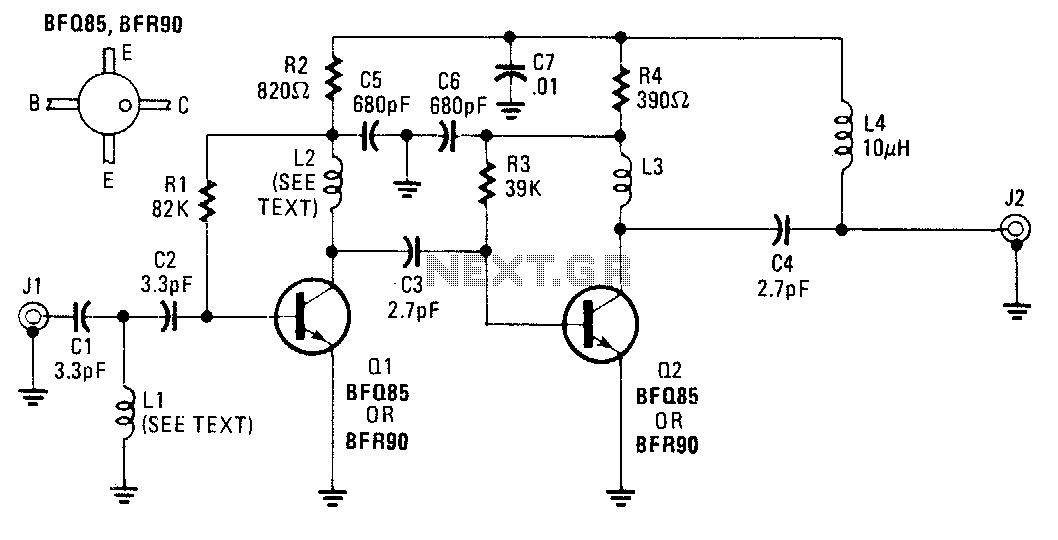
Uhf-tv-preamplifier

An inexpensive antenna-mounted UHF-TV preamplifier can add more than 25 dB of gain. The first stage of the preamplifier is biased for optimum noise performance, while the second stage is optimized for maximum gain. Additional details include Ll and L2, which are strip line components integrated into a portion of the printed circuit board.
The UHF-TV preamplifier is designed to enhance signal reception for ultra-high frequency television broadcasts. With a gain exceeding 25 dB, the device significantly amplifies weak signals captured by the antenna, improving overall picture quality and reducing noise interference.
The preamplifier consists of two stages: the first stage focuses on minimizing noise, which is crucial for maintaining signal integrity, especially in environments with high electromagnetic interference. This stage employs a careful biasing technique to ensure that the noise figure is kept to a minimum. The second stage is engineered for optimal gain, effectively boosting the signal strength for transmission to the television or receiver.
The use of strip line technology, represented by components Ll and L2, is essential in the design of the printed circuit board (PCB). Strip lines are a type of transmission line that provides controlled impedance and minimizes signal loss, making them ideal for high-frequency applications such as UHF TV signals. The placement and design of these strip lines on the PCB are critical for maintaining the performance characteristics of the preamplifier.
Overall, this UHF-TV preamplifier is a cost-effective solution for enhancing television reception, leveraging advanced design techniques to optimize both noise performance and gain. Its compact, antenna-mounted form factor ensures ease of installation and integration with existing antenna systems.An inexpensive. antenna-mounted, UHF-TV preamplifier can add more than 25 dB of gain. The first stage of the preamp is biased for optimum noise, the second stage for optimum gain. Ll, L2 strip line "" J../8 part of PC board. 🔗 External reference
The UHF-TV preamplifier is designed to enhance signal reception for ultra-high frequency television broadcasts. With a gain exceeding 25 dB, the device significantly amplifies weak signals captured by the antenna, improving overall picture quality and reducing noise interference.
The preamplifier consists of two stages: the first stage focuses on minimizing noise, which is crucial for maintaining signal integrity, especially in environments with high electromagnetic interference. This stage employs a careful biasing technique to ensure that the noise figure is kept to a minimum. The second stage is engineered for optimal gain, effectively boosting the signal strength for transmission to the television or receiver.
The use of strip line technology, represented by components Ll and L2, is essential in the design of the printed circuit board (PCB). Strip lines are a type of transmission line that provides controlled impedance and minimizes signal loss, making them ideal for high-frequency applications such as UHF TV signals. The placement and design of these strip lines on the PCB are critical for maintaining the performance characteristics of the preamplifier.
Overall, this UHF-TV preamplifier is a cost-effective solution for enhancing television reception, leveraging advanced design techniques to optimize both noise performance and gain. Its compact, antenna-mounted form factor ensures ease of installation and integration with existing antenna systems.An inexpensive. antenna-mounted, UHF-TV preamplifier can add more than 25 dB of gain. The first stage of the preamp is biased for optimum noise, the second stage for optimum gain. Ll, L2 strip line "" J../8 part of PC board. 🔗 External reference